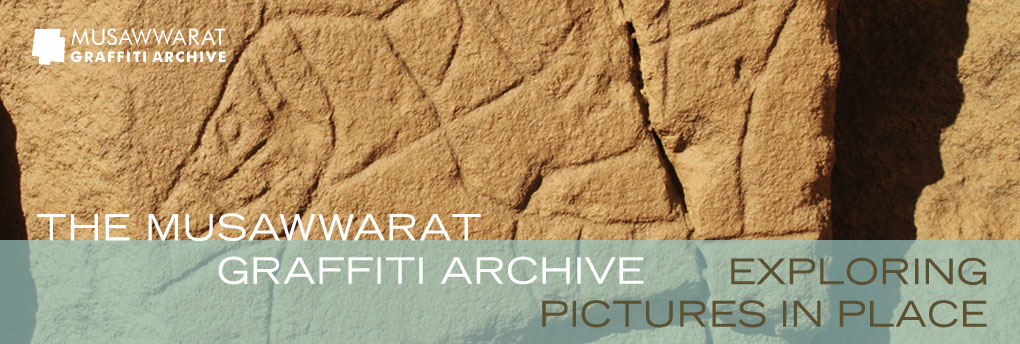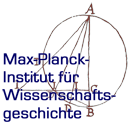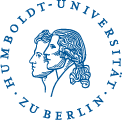Musawwarat Graffiti Project Team
Cornelia Kleinitz - Project Director (2007-2015)
Cornelia Kleinitz is an Africanist Archaeologist with a special interest in rock art and graffiti, the politics of archaeology and cultural heritage, and open access initiatives in the humanities. She studied History and Archaeology at Free University Berlin, Humboldt University Berlin and University College London. In London Cornelia became interested in the archaeology of Africa and in the dynamics of rock art making and usage. Her PhD thesis, which she submitted at the Institute of Archaeology at UCL, was entitled ‘Dialogues in Stone. Past and present engagements with rock art in sub-Saharan Mali, West Africa’. Cornelia moved on to positions at the Ethnographic Museum in Leiden and at the Max Planck Institute for the History of Science in Berlin, where she worked on open access initiatives in the humanities. At this time she became involved in archaeological rescue work at the Fourth Nile Cataract in northern Sudan, where she documented nearly 1000 rock art sites that are now lost under the waters of the Merowe Dam reservoir. Her involvement in archaeological salvage furthered her interest in the politics and ethics of archaeology and heritage.
In 2007, after she had moved to the Department of Egyptology and Northeast African Archaeology at Humboldt University Berlin, Cornelia began working on the graffiti of the Great Enclosure at Musawwarat es Sufra. She developed the Musawwarat Graffiti Project, which is dedicated to the documentation, study and publication of the historical graffiti at this singular site in Sudan. Her work involves on-site describing, mapping, photographing, drawing, tracing and RTI capturing graffiti, the development of a motif thesaurus and a database, database input and supervision, data analysis, the organisation of field and lab work, the writing of funding proposals and reports, and the presentation and publication of the project and its results. Since early 2011 she is also heading the development of the Musawwarat Graffiti Archive. During the year 2013 Cornelia continued the projects while being based at the Rock Art Research Institute at the University of the Witwatersrand, South Africa. After her return to Humboldt-University, she acted as deputy director of the Archaeological Mission to Musawwarat (until August 2015).
http://wits.academia.edu/CorneliaKleinitz
http://www.archaeologie.hu-berlin.de/personal/kleinitz/
Jens Weschenfelder - Documentation, Data Entry, Drawing, Supervision (2008-2015)
Jens Weschenfelder studied Archaeology and Cultural History of Northeast Africa at Humboldt University Berlin, focusing on the archaeology of Sudan. He has participated in numerous field projects in Egypt and Sudan, often as a pottery specialist. Due to his talents as a draftsperson, Jens became part of the Musawwarat Graffiti Project in 2008. After three field seasons documenting graffiti on site at Musawwarat, Jens spent the better part of 2011 and 2012 entering data into the project database and introducing new project members to its intricacies. Jens prepared most of the vector-based drawings of the graffiti for the project database and he has been also been working on the web-presentation of the ‘Graffiti in Place Database’. Jens is now running the excavation of a Kerma period cemetery on the Island of Mograt in northern Sudan, preparing work on his PhD-thesis.
Elisabeth Lindinger - Project Database Design (2011-2015)
Elisabeth Lindinger is a prehistorian with a special interest in the European Bronze Age. For the past few years she has been involved in several projects at the interface between archaeology and information technology. She is currently based at the Research Center for Culture and Informatics of the University of Applied Sciences (HTW) Berlin. For the Musawwarat Graffiti Project, Elisabeth designed the project database that serves for structuring the copious amounts of documentation and data generated in the course of the project, and she has been curating and updating the database as it has grown from field season to field season.
http://htw-berlin.academia.edu/ElisabethLindinger
Hembo Pagi – RTI documentation/Photogrammetry (2011)
Hembo Pagi was educated at the University of Helsinki and the University of Southampton, from where he holds an MSc in Archaeological Computing. He has been working for more than a decade providing technical solutions for different commercial IT and archaeological projects. Recently he has been focusing on imaging techniques and working at the University of Southampton as a research assistant and technician. Hembo is member of the Archaeological Computing Research Group, which is specialized on technological approaches in archaeological research. His current projects include the prospection of data management at the Archaeology Department of the University of Southampton, and a collaborative project with the University of Oxford on imaging techniques for ancient documents and rock art recording. In addition to imaging Hembo has been working on web applications for the presentation of archaeological data. Lately he received a grant for developing a website for archaeological sites in Estonia, his homeland. Hembo headed Reflectance Transformation Imaging (RTI) as well as photogrammetry work for the Musawwarat Graffiti Project during the 2011 field season.
http://soton.academia.edu/HemboPagi
Zaroog Bakri – Inspector of NCAM/RTI capture (2011-2015)
Zaroog Bakri, who was educated at Shendi University, is an archaeologist and restorer based at the National Corporation for Antiquities and Museums (NCAM) in Khartoum. Zaroog has been working at Musawwarat since 1995, when he got involved in restoration work at the site. In the past years Zaroog has been acting as the Inspector of Antiquities, the NCAM representative and project partner for all excavation and restoration work at Musawwarat. During the 2011 and 2012 field seasons Zaroog was part of the RTI-capture team that documented more than 1000 graffiti at the Great Enclosure. He also ensured the smooth running of the 2011 to 2015 field seasons of the Musawwarat Graffiti Project.
Hassan Ibidallah – Logistics/RTI capture (2011-2015)
Hassan Ibidallah has been based at Musawwarat since 1995. Already his father had been involved in work at Musawwarat during the Humboldt University excavations of the 1960s. Over the past years Hassan has been organising the local workmen during restoration and excavation projects at the site as well as keeping an eye on the dig house. Hassan is part of the Musawwarat logistics team. During the 2011 and 2012 field seasons he also worked with the graffiti field team, where he was primarily involved in RTI-capture for the Musawwarat Graffiti Project.
Mohammed el Tayeb – Logistics manager/RTI capture (2011-2015)
Mohammed el Tayeb has been part of the Musawwarat Graffiti Project since the 2011 field season, acting as the logistics manager of the project, but also supporting graffiti documentation on site. After having completed his education in Khartoum, he worked in a series of jobs as an office employee, mechanic, driver, logistics manager, cook and tour operator. For the past 15 years he has been accompanying tourist tours to the archaeological sites and other sights of Sudan. He has ventured as far as Malakal in southern Sudan, Jebel Uweinat in the far north of Sudan, Berenike on the Red Sea and the Nuba mountains and Darfur in the west of the country. In the future Mohammed would like to go to university to study – maybe to become an archaeologist.
Julia D. Preisigke – Documentation and Data Entry (2011)
Julia Preisigke studied Archaeology and Cultural History of Northeast Africa at Humboldt University Berlin. She completed her Bachelor of Arts in 2010 and her Master of Arts in 2013. Since 2008 she has been involved in an ongoing excavation (9 campaigns) of the German Archaeological Institute Cairo at Abydos/Umm el-Qaab in Egypt. Her work in the project “Cult of Osiris” mainly includes documenting, drawing and photographing pottery dating from the Middle Kingdom to the Late Period. Julia joined the Musawwarat Graffiti Project for the 2011 field season, documenting graffiti on site as well as working on the project database and preparing drawings. She is now a Fellow at the Graduate School 'Distant Worlds' at Ludwig-Maximilians-Universität Munich and the Münchner Zentrum für Antike Welten (MZAW). Her PhD focuses on counter temples and other spaces at and within temples, in which lay people were able to communicate with the respective god.
Dina Serova – Documentation and Data Entry (2011-2013)
Dina Serova holds a Bachelor of Arts in Archaeology and Cultural History of Northeast Africa from Humboldt University Berlin. She studied for a Masters degree in Archaeology and Cultural History of Northeast Africa / Egyptology at Humboldt University Berlin and Free University Berlin, which she completed in 2014. Dina has a keen interest in the theory and practice of archaeological (field) research as well as linguistic studies. Since 2015 she has been working on her PhD, which is focused on the perception of the human body in Ancient Egypt and Nubia. Dina has taken part in field projects in Egypt and Sudan. During the 2011 and 2013 field seasons Dina documented graffiti on site in the Great Enclosure of Musawwarat as well as working on the project database and preparing drawings.
Franziska Lehmann – Documentation and Data Entry (2011-12, 2014-15)
Franziska is a student of Greek and Roman Archaeology at Humboldt University Berlin. During her BA studies she has also become interested in the archaeology of the Middle Nile valley, pursuing courses on its history and archaeology. Franziska became a member of the Musawwarat Graffti Project in late 2011, when she started supporting data entry into the project database. She was part of the 2012 field team to Musawwarat, where she documented graffiti and entered data into the project database. She returned in 2014 as a student assistant to the project and - apart from documenting graffiti at Musawwarat - is now helping to build a database of comparative material for the Musawwarat graffiti.
Juliette Brauer – Documentation and Data Entry (2012-2014)
Juliette studied Archaeology and Cultural History of Northeast Africa at Humboldt University Berlin. She joined the Musawwarat Graffiti Project as a volunteer in 2012. In 2013 and 2014 she was a student assistant for the project, taking part in three field seasons. Juliette documented graffiti on site and also entered large amounts of field data into the project database. In her BA-thesis she investigated an aspect of the Musawwarat graffiti, discussing depictions of what appear to be birds. For the moment, Juliette has left archaeology and is working (again) as a medical assistant.
Agata Sander – Documentation and Data Entry (2013-2015)
Agata Sander holds a Master of Arts in Archaeology from Adam Mickiewicz University in Poznan, Poland. Since her graduation she has been involved in and has led numerous rescue excavations in Poland and Germany. From 2005 onwards she has also been working in Sudan and Qatar. The foci of her interest have been problems associated with complex stratigraphy encountered on multi-period archaeological sites as well as critical approaches to the documentation and subsequent reconstruction of (Medieval) architectural features. Her work in Sudan first concerned research on prehistoric rock art in the Third Cataract region and later involved the study of Napatan and Meroitic temple structures on the ‘Island of Meroe’. In 2013 Agata joined the Musawwarat Graffiti Project where she is now leading the preparation of field drawings and field descriptions, and is concerned with project database curation and input.
Victoria Grünberg – Documentation and Data Entry (2013-2015)
Victoria is a student at the Department of Northeast African Archaeology and Cultural Studies at Humboldt University in Berlin. She joined the Musawwarat Graffiti Project as a volunteer in 2013 and 2014 and became a student assistant for the project in early 2015. During three field seasons, Victoria documented graffiti in the Great Enclosure and worked on the database of the project. Victoria will discuss some graffiti, which seem to be depictions of baboons, in her BA-thesis.
Roswitha Koenitz – Documentation, Data Entry and Archival Work (2014)
Ole Fredrik Unhammer – Photogrammetry and 3D-Modeling (2015)
Ole Fredrik is a student of archaeology at the University of Bergen, Norway. His BA focused on the economy of pioneering Stone Age settlers of Norway. He is currently writing an MA on the use of digital photogrammetry in archaeology, recording South African Middle Stone Age (MSA) cave and rock shelter sites and Norwegian Bronze Age ceramics. Having become interested in digital recording of rock art through is MA work, Ole joined the Musawwarat Graffiti Project as a volunteer in March 2015, when he headed the photogrammetric documentation of hundreds of ancient graffiti at the Great Enclosure at Musawwarat. His work comprised the development of a suitable methodology for the digital documentation of the fragile Musawwarat graffiti in terms of scale and resolution versus investment of time, with the aim of producing 3D-models and/or orthophotos of the graffiti, their block support and the walls on which they are found that are useful for research as well as constituting a digital copy of the graffiti in case of their destruction.
Robert Kell - Photogrammetry and 3D-Modeling (2015)
Robert Kell started his studies of Graeco-Roman Archaeology at Humboldt University in Berlin in late 2012, focusing especially on the Aegean Bronze Age. He is currently in the last semester of his Bachelor of Arts. Robert joined the Musawwarat Graffiti Project in 2015, when he joined Ole Unhammer in the photogrammetric documentation of the graffiti of the Great Enclosure, which ranged from single blocks with their graffiti to the recording of entire walls. Robert also took part in processing the sets of photos and in creating 3D models and orthophotos. For the future, Robert would like to digitally preserve as many of the graffiti as possible and help to make these data publicly available.
Dora Ehrensperger - Documentation and Data Entry (2015)
Dora, after having graduated in engineering and having worked in this field for several years, started to study archaeology alongside work in 2012. She is now a BA student at the Department of Northeast African Archaeology and Cultural Studies at Humboldt University. Dora gained first experience in practical fieldwork in Kabyle/Bulgaria in summer 2014. In spring 2015, she volunteered for the Musawwarat Graffiti Project, after having pursued a course about the history and culture of the Middle Nile Valley, which raised her interest in this project. During her stay at Musawwarat, she documented graffiti and supported database entry for the project.
Jaroslav Halik - Documentation and Data Entry (2015)
Born and bred in the Czech Republic, Jaroslav Halik started his studies of Egyptology at Leipzig University. After an internship at the Egyptian Museum and Papyrus Collection in Berlin he continued to follow his interest in Egyptology at Berlin’s Free University. Currently he is completing a BA degree at the Department of Northeast African Archaeology and Cultural Studies at Humboldt University Berlin. Jaroslav is especially interested in ancient religious philosophy as well as in ancient architecture and its embeddedness in the landscape. In terms of fieldwork, Jaroslav had taken part in two study trips to Egypt in the past and participated in several excavation seasons in Germany, before he became a student assistant for the Archaeological Mission to Musawwarat es Sufra, Sudan. His main tasks during the spring 2015 season were the drawing of finds, especially pottery, and the recording ancient graffiti at the Great Enclosure.
Texts: Cornelia Kleinitz & individual project members (last update: 12/04/2015)





















